C2 PROJECT
C2 Project News
Autumn working party reports 2025
News from the autumn working parties.
The working partied this autumn have been relatively small affairs, with just Andrew and Dave 1 normally in attendance. But that has not prevented good progress being made.
The September working party was a little unusual in that we didn't cut any metal. Instead, Andrew and Dave spent two days sat in the C2 Shed, planning out future tasks. While this was largely computer based, working in the C2 Shed with the locomotive in front of us was very beneficial. Working through the list of motion parts (and there are hundreds of them), each was assessed against the original drawings and a decision made as to whether to reuse, repair or remake each. Being able to measure the existing components aided this process enormously. By the end of the working party, Andrew had taken away a list of materials and tools to buy while Dave took away a list of drawings to create.
There was a time gap between the September and October working parties, during which Andrew managed a few more days working at Boston Lodge. Having previously machined the first crosshead bottom slipper, he started to machine the corresponding top slipper. The top slippers cannot be machined in situ, so the amount of metal removal has to be determined relative to the bottom slipper before the slipper is removed and machined on the table of the milling machine. It takes a lot of careful measurement while fitted, then again while setting up on the milling machine.
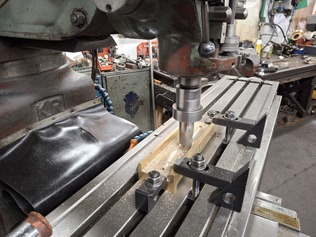
Machining one of the top cross head slippers.
Andrew was also able to take measurements of the piston rod gland housings, which he sent to Dave 1 at home. Dave had drawn up all of the piston rod packing and gland components, and with the housing dimensions known (they are not to the original design), he was able to create an assembly drawing showing how the glands and packing fit together. The inexplicable 'extra' spacer ring suddenly made sense when we realised that the Driver's and Fireman's side packing housings have been machined to quite different dimensions!


Disassembling the glands using the press
Difference between the drivers and fireman side glands

Due to seasonal illness, the October working party took place a week later than planned. Andrew and Dave set up the second crosshead, complete with piston rod, bottom slipper, etc., on the Archdale milling machine. Using the knowledge gained from machining the first crosshead bottom slipper, the process was a great deal easier this time! Chris dropped in to say hello, and suggested using an angle plate to help us locate the edge of the piston rod; a great idea which saved us more time. The first crosshead bottom slipper had taken us almost five days to set up and machine. The second took just two days. This gave Andrew time to machine a recess for whitemetal in the slipper as well.
While Andrew machined the slipper, Dave turned up some stainless steel pins for the reverser linkages.
Dave making pins for the reverser linkage
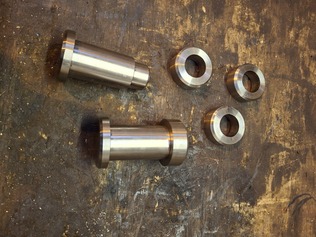
It was only just over a week later that we returned for the November working party. Andrew continued work on the crosshead slippers, machining the second crosshead top slipper. After this, he machined recesses for whitemetal in the remaining slippers. This was done using the CNC milling machine, which can be programmed to mill slots of a defined length and width.
All 4 cross head slippers with recesses for the white metal.

The existing 11mm diameter holes for M10 screws holding the slippers to the crossheads are badly worn and no longer round. We have therefore decided to replace the screws with M12 and machine the holes out to 13mm diameter. The screw heads are countersunk into the slippers, so Andrew drilled and countersunk the slippers accordingly. Care was needed to ensure that the holes in the slippers align with the holes in the crosshead castings.
While Andrew was machining the slippers, Dave turned up a set of plugs to fit into the screw holes in the crosshead slippers. These are necessary when pouring whitemetal into the recesses in the slippers, to prevent the whitemetal pouring straight out through the holes.
Dave also turned up some more stainless steel pins, this time for the radius rod/combination lever joints. All the pins require collars of a common design, so Dave turned up a batch of these too. The collars fit over the ends of the pins and are held in place with split pins. Dave drilled holes for the split pins with the collars and pins assembled together to ensure they aligned. He used a cobalt drill for this operation, since stainless steel is not an easy material to drill (it work hardens as it is machined).
More pins made by Dave.
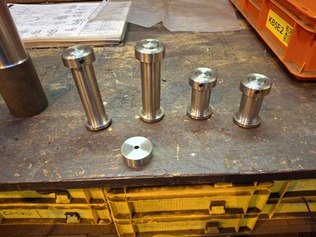
Andrew had made excellent progress on the crosshead slippers, and so spent the final day filling the recesses with whitemetal. It is a long time since we whitemetalled the main axlebox bearings, so Andrew had to remember how it was done. But he had little trouble doing so, and now all four crosshead slippers are whitemetalled and ready for final machining.
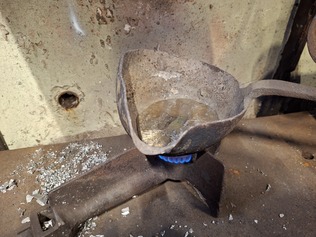
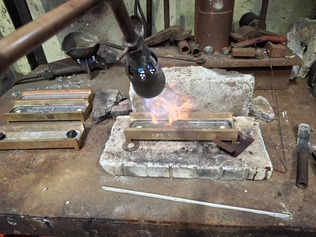
Melting the white metal
Heating the cross head slippers ready for pouring whitemetal.
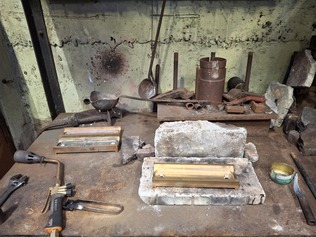
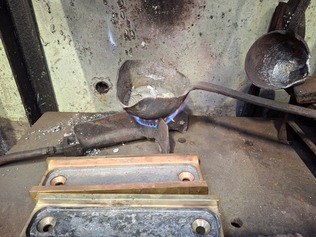
The whitemetalling bay.
Freshly poured whitemetal.
While assessing the motion parts, Dave has noticed that the two lifting links are slightly different lengths. Whether this is by design or just due to dodgy machining is unclear. It may be that the different lengths are to compensate for the cranks on the reverser weighshaft being imperfectly aligned, so we wish to measure the position of the crank pins relative to the expansion link bearings on the motion brackets. To do so, Dave turned up a length of tube (lighter and more manageable than solid) which fits precisely in the bearing holes in the motion brackets. We will use this at the next working party to try and take some accurate measurements of the relative positions of the motion pivot points.
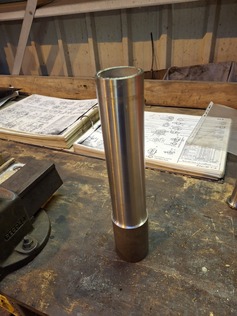
Length of tube for measuring the lifting the relative positions of the motion pivot points.
Thanks to the planning session in September, we now have drawings, tools and suitable material available to manufacture many of the motion parts. Early December will see us return to Boston Lodge to complete work on the crossheads and to continue working on the motion.
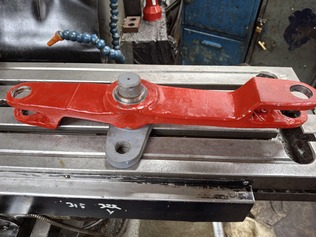
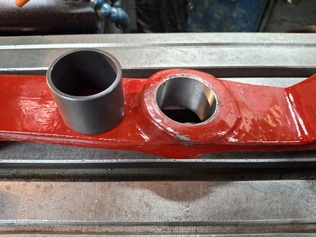
Reverser intermediate crank with new pivot bush.
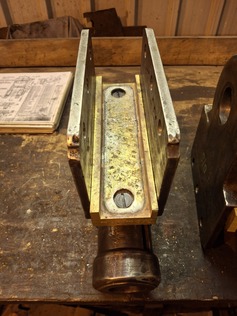
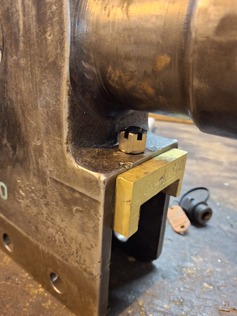
Cross head bottom slippers ready to machine the white metal at the next working party
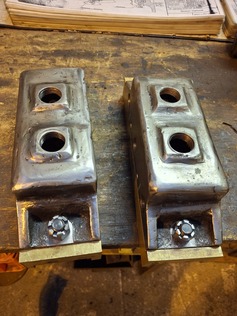
cross head top slippers
Cross head top slipper
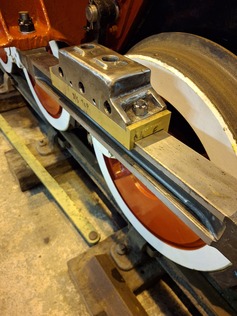
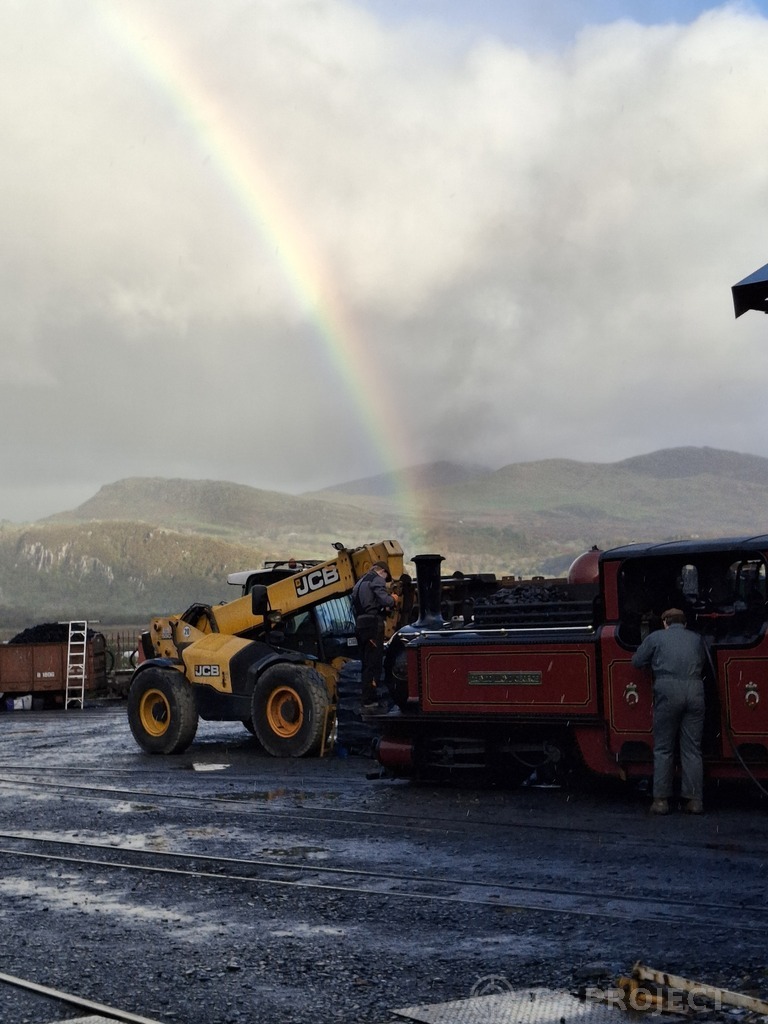
Finally - It's amazing what comes out of a double engine chimney at times!